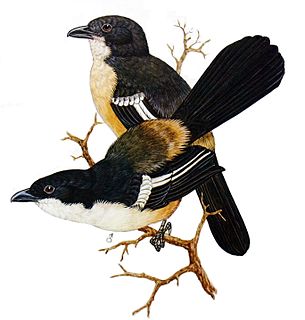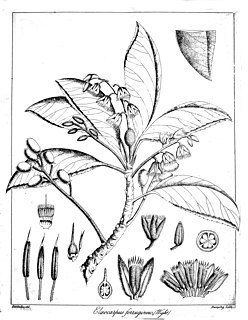
Pera is a genus of the flowering plant family Peraceae, first described as a genus in 1784. It is native to tropical America, from southern Mexico and the West Indies south as far as Paraguay.

Chaetocarpus is a plant genus of the family Peraceae, formerly Euphorbiaceae, first described as a genus in 1854. Chaetocarpus species are trees or shrubs. They are native to the Americas, Africa, and Asia. Some species are endangered.
- Chaetocarpus acutifolius(Britton & P.Wilson) Borhidi - Sierra de Moa in Cuba
- Chaetocarpus africanusPax - C Africa
- Chaetocarpus castanocarpus(Roxb.) Thwaites - SE Asia, Yunnan, Assam, Bangladesh, Sri Lanka
- Chaetocarpus cordifolius(Urb.) Borhidi - Cuba, Hispaniola, Jamaica
- Chaetocarpus coriaceusThwaites - Sri Lanka
- Chaetocarpus cubensisFawc. & Rendle - Cuba
- Chaetocarpus echinocarpus (Baill.) Ducke - Bolivia, Brazil
- Chaetocarpus ferrugineusPhilcox - Sri Lanka
- Chaetocarpus gabonensisBreteler - Gabon
- Chaetocarpus globosus(Sw.) Fawc. & Rendle - Jamaica, Cuba, Dominican Rep.
- Chaetocarpus myrsinitesBaill. - Bolivia, Brazil
- Chaetocarpus parvifoliusBorhidi - Cuba
- Chaetocarpus pearceiRusby - Bolivia
- Chaetocarpus pubescens(Thwaites) Hook.f. - Sri Lanka
- Chaetocarpus rabarabaCapuron - Madagascar
- Chaetocarpus schomburgkianus(Kuntze) Pax & K.Hoffm. - Colombia, Venezuela, 3 Guianas, NW Brazil
Discocarpus is a genus of the plant family Phyllanthaceae first described as a genus in 1841. It is native to northern South America. It is dioecious, with male and female flowers on separate plants.
- Discocarpus essequeboensisKlotzsch - Brazil, Venezuela (Amazonas), Guyana, Suriname, French Guiana
- Discocarpus gentryiS.M.Hayden - S Venezuela (Amazonas), Peru (Loreto), N Brazil
- Discocarpus pedicellatusFiaschi & Cordeiro - State of Bahia in Brazil
- Discocarpus spruceanusMüll.Arg. - Venezuela (Amazonas), Brazil, Suriname (Sipaliwini), Bolivia

The tawny nurse shark is a species of carpet shark in the family Ginglymostomatidae, and the only extant member of the genus Nebrius.
The Rio de Janeiro arboreal rat is a rodent species from South America. It is found in Brazil. It is the only species in the genus Phaenomys.

The rusty pitohui is a species of bird in the family Pachycephalidae. It is found throughout the lowlands of the Aru Islands and New Guinea.

Nepenthes × ferrugineomarginata is a natural hybrid between N. albomarginata and N. reinwardtiana. It has been recorded from the islands of Borneo and Sumatra. The type specimen was collected by Shigeo Kurata in Kenukat, West Kalimantan, in 1981. Kurata described the hybrid the following year. The name is a nomen invalidum as it was published without a Latin description.

The southern boubou is a bushshrike. Though these passerine birds and their relations were once included with true shrikes in the Laniidae, they are not closely related to that family.

The palm weevil Rhynchophorus ferrugineus is one of two species of snout beetle known as the red palm weevil, Asian palm weevil or sago palm weevil. The adult beetles are relatively large, ranging between 2 and 4 centimetres long, and are usually a rusty red colour—but many colour variants exist and have often been classified as different species. Weevil larvae can excavate holes in the trunks of palm trees up to 1 metre (3.3 ft) long, thereby weakening and eventually killing the host plant. As a result, the weevil is considered a major pest in palm plantations, including the coconut palm, date palm and oil palm.

The austral parakeet, austral conure, or emerald parakeet is a parrot found from the southern tip of South America – further south than any other parrot – to as far north as Temuco. It is a fairly large conure, 35 cm. It is primarily green, lightly barred, with some dull red on the forehead and lores, belly, and upper tail, with the northern part of the range displaying less red.

Elaeocarpus ferrugineus is a species of flowering plant in the Elaeocarpaceae family. It is a tree endemic to Peninsular Malaysia.

The ferruginous-backed antbird is a species of passerine bird in the family Thamnophilidae. It inhabits the Guyanas and the northern Amazon Basin. Its natural habitat is subtropical or tropical moist lowland forests.
Deronectes ferrugineus is a species of beetle in family Dytiscidae. It is endemic to Portugal.

The Kopuatai Peat Dome is a large peatland complex on the Hauraki Plains in the North Island of New Zealand. It consists of two raised domes, one in the north and the other in the south, that are up to three metres higher at the center than at the edge. The 10,201 hectares wetland contains the largest intact raised bog in New Zealand and was listed under the Ramsar Convention in 1989 as a Wetland of International Importance. Most of the wetland is ombrotrophic, meaning it receives water and nutrient inputs solely from rain and is hydrologically isolated from the surrounding canals and rivers. Locally, a popular misconception persists that water flows from the nearby Piako River into the bog and that the wetland acts as a significant store for floodwater.

Leistus ferrugineus is a species of ground beetle native to the Palearctic and the Nearctic.

Tylopilus ferrugineus is a bolete fungus in the family Boletaceae native to North America. Originally described by Charles Christopher Frost in 1874 as Boletus ferrugineus, it was placed in the genus Tylopilus by Rolf Singer in 1947.

Peraceae Klotzsch is a family of flowering plants in the eudicot order Malpighiales. The family was segregated from the Euphorbiaceae by Johann Friedrich Klotzsch in 1859, and its uniqueness was affirmed by the Royal Botanic Gardens, Kew's Euphorbiaceae expert, Airy Shaw.
Chaetocarpus castanocarpus is a plant of the family Peraceae. The tree is evergreen and about 45 metres (148 ft) high. Leaves are simple and alternate. Flower color may vary from greenish yellow to yellow. It is distributed in Myanmar, Cambodia, Indonesia, India, Sri Lanka, Thailand, Andaman Islands, Bangladesh, Vietnam and Laos. Tree trunk is used for construction purposes. Leaves are used as a leafy vegetable.
Callibaetis ferrugineus is a species of small minnow mayfly in the family Baetidae. It is found in North America.
Xyleborus ferrugineus is a species of typical bark beetle in the family Curculionidae.












